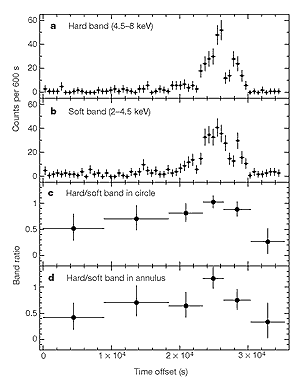Sag A*
Credit: F. K. BAGANOFF, et al. The center of the Milky Way lies behind a dusty cloud of gas and a clustering of stars in the constellation Sagittarius. The closest object to the actual centre, discovered in 1974, is a bright compact source of radio waves known as Sagittarius A*. Some ten million stars swarm within a light year of its position, the closest three or four of which swing past it at incredible speeds, up to five million kilometres per hour. The central mass required to keep these stars in their frantic orbits (just 7 light days away from the center) is equal to 2.6 million solar masses, which suggests that the dark force powering Sagittarius A* is a black hole ‹ an object so dense that gravity prevents everything, even light, from escaping. All this matter appears to be concentrated at the Galactic Centre in a region no bigger than our Solar System, and probably smaller than the region within Mars' orbit around the Sun. The event reported by Baganoff et al. is the remarkable discovery by the Chandra X-ray Observatory, late last year, of a short-duration, highly variable, X-ray flare produced by Sagittarius A*. It was over in a couple of hours, but while it lasted about 45 times as many X-rays were being emitted per second as are usually produced when Sagittarius A* is quiet. Even more startling was the observation that, during the flare, the X-ray output dropped abruptly by a factor of about five in less than ten minutes, and then recovered almost as quickly. Such breathless variability is rarely seen in emissions from ponderous multi-million solar-mass objects. It is far more common, however, with solar-sized objects, such as a neutron star accreting gas from its orbiting companion. And that's what makes it interesting. Variability is a powerful indicator of the size of the radiating region, because nothing can travel faster than light. For an entire object's luminous output to vary considerably over a short interval, all its various parts must be able to 'communicate' their changes to each other within that time. An abrupt change in the X-ray emission from Sagittarius A* over ten minutes means that the compressed, hot, radiating gas could not have been distributed over a region bigger than the distance between Earth and the Sun, this being the distance traversed by a light beam during that interval. By comparison, the radius of Sagittarius A*'s event horizon is thought to be only about 20 times smaller. This is why the discovery reported by Baganoff et al. is so exciting, because it places the 2.6 million solar masses calculated from the movements of stars into a region at most 20 times larger than that predicted for this black hole by general relativity. By squeezing the radius allowed for the central dark matter by a factor of 1,500, Baganoff et al. appear to have excluded all other plausible alternatives. Text credit: FULVIO MELIA, Nature 413, 25-26, 2001
IMAGES |
By Mission |
Stars |
HEASARC Home | Observatories | Archive | Calibration | Software | Tools | Students/Teachers/Public Last modified: Thursday, 26-Jun-2003 13:48:46 EDT |


